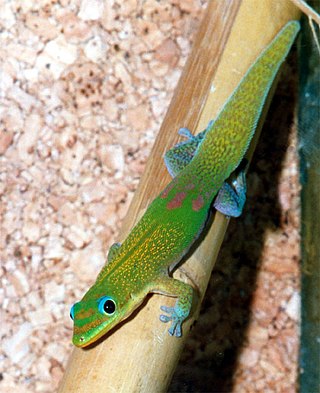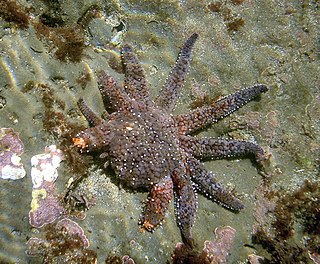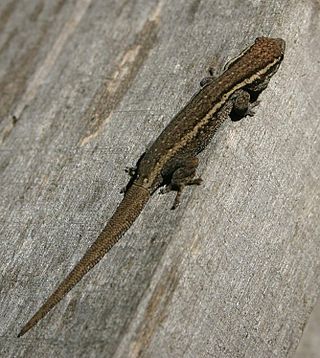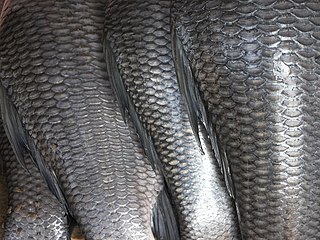
Ecdysis is the moulting of the cuticle in many invertebrates of the clade Ecdysozoa. Since the cuticle of these animals typically forms a largely inelastic exoskeleton, it is shed during growth and a new, larger covering is formed. The remnants of the old, empty exoskeleton are called exuviae.

Geckos are small, mostly carnivorous lizards that have a wide distribution, found on every continent except Antarctica. Belonging to the infraorder Gekkota, geckos are found in warm climates throughout the world. They range from 1.6 to 60 centimetres.

Lizards are a widespread group of squamate reptiles, with over 7,000 species, ranging across all continents except Antarctica, as well as most oceanic island chains. The group is paraphyletic since it excludes the snakes and Amphisbaenia, although some lizards are more closely related to these two excluded groups than they are to other lizards. Lizards range in size from chameleons and geckos a few centimeters long to the 3-meter-long Komodo dragon.

Skin is the layer of usually soft, flexible outer tissue covering the body of a vertebrate animal, with three main functions: protection, regulation, and sensation.

Keratin is one of a family of structural fibrous proteins also known as scleroproteins. Alpha-keratin (α-keratin) is a type of keratin found in vertebrates. It is the key structural material making up scales, hair, nails, feathers, horns, claws, hooves, and the outer layer of skin among vertebrates. Keratin also protects epithelial cells from damage or stress. Keratin is extremely insoluble in water and organic solvents. Keratin monomers assemble into bundles to form intermediate filaments, which are tough and form strong unmineralized epidermal appendages found in reptiles, birds, amphibians, and mammals. Excessive keratinization participate in fortification of certain tissues such as in horns of cattle and rhinos, and armadillos' osteoderm. The only other biological matter known to approximate the toughness of keratinized tissue is chitin. Keratin comes in two types, the primitive, softer forms found in all vertebrates and harder, derived forms found only among sauropsids.

The integumentary system is the set of organs forming the outermost layer of an animal's body. It comprises the skin and its appendages, which act as a physical barrier between the external environment and the internal environment that it serves to protect and maintain the body of the animal. Mainly it is the body's outer skin.

Geckolepis is a genus of geckos, commonly referred to as fish scale geckos, which are endemic to Madagascar and the Comoro Islands. They are nocturnal, arboreal, insectivorous lizards, found in primary and secondary forest, as well as degraded habitats. They are best known for their ability to lose their skin and scales when grasped by a predator.

Keratinocytes are the primary type of cell found in the epidermis, the outermost layer of the skin. In humans, they constitute 90% of epidermal skin cells. Basal cells in the basal layer of the skin are sometimes referred to as basal keratinocytes. Keratinocytes form a barrier against environmental damage by heat, UV radiation, water loss, pathogenic bacteria, fungi, parasites, and viruses. A number of structural proteins, enzymes, lipids, and antimicrobial peptides contribute to maintain the important barrier function of the skin. Keratinocytes differentiate from epidermal stem cells in the lower part of the epidermis and migrate towards the surface, finally becoming corneocytes and eventually be shed off, which happens every 40 to 56 days in humans.

The leopard gecko or common leopard gecko is a ground-dwelling lizard native to the rocky dry grassland and desert regions of Afghanistan, Iran, Pakistan, India, and Nepal. The leopard gecko has become a popular pet, and due to extensive captive breeding it is sometimes referred to as the first domesticated species of lizard.

In biology, regeneration is the process of renewal, restoration, and tissue growth that makes genomes, cells, organisms, and ecosystems resilient to natural fluctuations or events that cause disturbance or damage. Every species is capable of regeneration, from bacteria to humans. Regeneration can either be complete where the new tissue is the same as the lost tissue, or incomplete after which the necrotic tissue becomes fibrosis.

Autotomy or self-amputation, is the behaviour whereby an animal sheds or discards one or more of its own appendages, usually as a self-defense mechanism to elude a predator's grasp or to distract the predator and thereby allow escape. Some animals have the ability to regenerate the lost body part later. Autotomy has multiple evolutionary origins and is thought to have evolved at least nine times independently in animals. The term was coined in 1883 by Leon Fredericq.

Santanaraptor is a genus of tyrannosauroid theropod dinosaur that lived in South America during the Early Cretaceous, about 112 million years ago.
Snakeskin may either refer to the skin of a live snake, the shed skin of a snake after molting, or to a type of leather that is made from the hide of a dead snake. Snakeskin and scales can have varying patterns and color formations, providing protection via camouflage from predators. The colors and iridescence in these scales are largely determined by the types and amount of chromatophores located in the dermis of the snake skin. The snake's skin and scales are also an important feature to their locomotion, providing protection and minimizing friction when gliding over surfaces.

The human skin is the outer covering of the body and is the largest organ of the integumentary system. The skin has up to seven layers of ectodermal tissue guarding muscles, bones, ligaments and internal organs. Human skin is similar to most of the other mammals' skin, and it is very similar to pig skin. Though nearly all human skin is covered with hair follicles, it can appear hairless. There are two general types of skin, hairy and glabrous skin (hairless). The adjective cutaneous literally means "of the skin".

Bolitoglossa is a genus of lungless salamanders, also called mushroom-tongued salamanders, tropical climbing salamanders, or web-footed salamanders, in the family Plethodontidae. Their range is between northern Mexico through Central America to Colombia, Venezuela, Ecuador, Peru, northeastern Brazil, and central Bolivia. Neotropical salamanders of the Bolitoglossa make up the largest genus in the order Caudata, consisting of approximately one-fifth of all known species of salamanders. Adult salamanders range anywhere from 45mm to 200mm in length depending on their specific species. They are notorious for their ability to project their tongue at prey items, as indicated from their name. They are also known for their webbed feet, having significantly more webbing than any other species outside their genus with the exception of the cave-dwelling Mexican bolitoglossine Chiropterotriton magnipes. Although webbed feet are a common characteristic of these salamanders, only about half of the species in this genus contain webbed feet.

Reptile skin is covered with scutes or scales which, along with many other characteristics, distinguish reptiles from animals of other classes. They are made of alpha and beta-keratin and are formed from the epidermis. The scales may be ossified or tubercular, as in the case of lizards, or modified elaborately, as in the case of snakes.

The Cape dwarf gecko ('lygodactylus' = 'flexible fingers') is a species of dwarf gecko found in the woodlands and forests of central and southern Africa. It also occurs commonly in towns and cities and is sometimes kept as a pet.

A fish scale is a small rigid plate that grows out of the skin of a fish. The skin of most jawed fishes is covered with these protective scales, which can also provide effective camouflage through the use of reflection and colouration, as well as possible hydrodynamic advantages. The term scale derives from the Old French escale, meaning a shell pod or husk.
Geckolepis humbloti, commonly known as the Comoran fish scale gecko, is a nocturnal species of lizard in the family Gekkonidae. It is endemic to Grande Comore in the Comoros.

Starfish, or sea stars, are radially symmetrical, star-shaped organisms of the phylum Echinodermata and the class Asteroidea. Aside from their distinguished shape, starfish are most recognized for their remarkable ability to regenerate, or regrow, arms and, in some cases, entire bodies. While most species require the central body to be intact in order to regenerate arms, a few tropical species can grow an entirely new starfish from just a portion of a severed limb. Starfish regeneration across species follows a common three-phase model and can take up to a year or longer to complete. Though regeneration is used to recover limbs eaten or removed by predators, starfish are also capable of autotomizing and regenerating limbs to evade predators and reproduce.

















